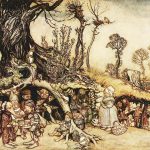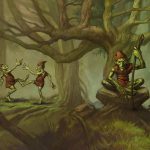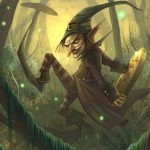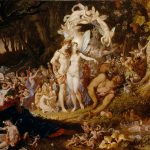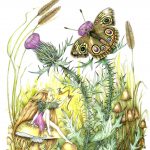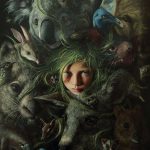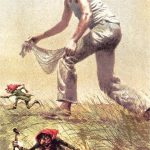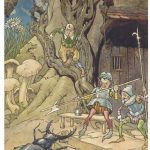Fairies are fond of dancing and playing music. They share this trait with the fauns and satyrs who escorted Dyonisos.
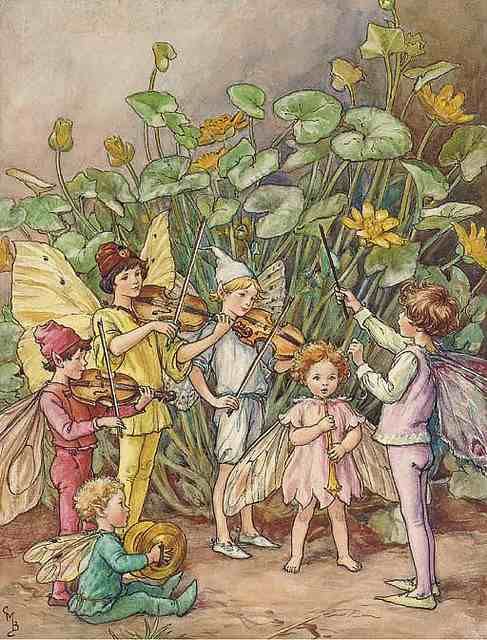
In Ireland and Scotland, many pipers and fiddlers learnt their songs or even their trade from the Fairies. In the same way that the famous bluesmen of America get their fame through a pact with devil, some musicians pretend that the fairies are behind some famous songs.
John Spence of Shetland learned “The Trowie Reel” while asleep on the Fairy Hill of Gulla Hammar. The blind harpist O’Carolan of Ireland acquired his musical genius when he slept upon a fairy rath one night. The famous tune, “Londonary Aire” was supposedly a fairy tune originally.
On the Isle of Man, this story is told about a fiddler named Bill Pheric:
Bill Pheric was coming home late one night across the mountains from Druidale, and heard the fairies singing, just as he was going over the river by the thorntree that grows there. The tune they had was Bollan Vane, and he wanted to learn it from them, so he went back three times before he could pick it up and remember it, but after the third time he had it by heart.
Just then the sun got up and the fairies went away, for they always do at sunrise. He came home whistling the tune, and since then it has been popular and much played on the fiddle. Many people think that Bill Pheric invented the tune, but he didn’t, he got it from the fairies.
From J. G. Campbell:
The Elves are great adepts in music and dancing, and a great part of their times seems to be spent in the practice of these accomplishments. The changeling has often been detected by his fondness for them. Though in appearance an ill-conditioned and helpless brat, he has been know, when he thought himself unobserved, to play the pipes with surpassing skill, and dance with superhuman activity. Elfin music is more melodious than human skill and instruments can produce, and there are many song and tunes which are said to have been originally learned from the Fairies. The only musical instrument of the Elves is the bagpipes, and some of the most celebrated pipers in Scotland are said to have learned their music from them.
From Lady Wilde:
The fairies are passionately fond of music; it is therefore dangerous for a young girl to sing when she is all alone by the lake, for the spirits will draw her down to them to sing to them in the fairy palace under the waves, and her people will see her no more. Yet sometimes when the moonlight is on the water, and the waves break against the crystal columns of the fairy palace far down in the depths, they can hear her voice, and they know that she is singing to the fairies in the spirit land beneath the waters of the lake.
From Caoimhin MacAoidh:
To the older generations, fiddle-playing was seen as a gift in itself and the way in which a person came to acquire this craft was commonly enveloped in a mantle of folklore. Two variations of a folklore motif, both of which have been excellently explored in Daithi O hOgáin’s book “An File”, were regularly used to explain how a person came to become gifted in fiddle-playing.
In the first instance, a simple person, usually with no formal education or particular talents, is journeying home at night. He decides to sleep in a faerie rath and is mysteriously awoken. Beside him he finds a book, a pen, and a fiddle which have been left by the faeries.
By expressing interest in the book, the person is given the gift of poetry; the pen signifies the gift of prose while the fiddle bestows the gift of music. The faeries must get something in return however and after choosing, the pen usually leaps up blinding the person in one or both eyes. In the second version, the person is sleeping in the rath and is awoken by faeries who invite him/her into the fort, through a secret door, to attend a dance.
The person must be careful not to eat or drink as this will entrap him as one of the faerie folk and he will be permanently lost from the human world. During the night, he is offered either a book, a pen or a fiddle with the same results as in the first version of the motif.
Four fiddlers and a piper were playing for dancers at a bonfire gathering on St. John’s Eve when a stranger came into the company and requested the best of the fiddlers, a Mac Fhionnlach from Falcarragh to play The Fairy Reel. Mac Fhionnlach was unable to play the tune and the stranger took up the fiddle and gave a masterful performance.
He handed the fiddle back to the Falcarragh man and told him “Now there’s your fidil for you. Turn on the `Reel’. Play it after me for you’re the only man in the Five Kingdoms that can do the same!” Mac Fhionnlach was able to play away at it “without break” while the stranger danced with a young girl.
At the finish he slipped a gold coin into her hand and left requesting the company to move the fire seven paces to the north. It is clear from the latter point that the stranger was a faerie and the bonfire was set on one of the faeries’ “gentle places”.

